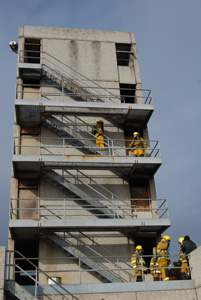Editorial
Front Page - Friday, December 18, 2009
Chattanooga Fire Training Center educates tomorrow’s heroes
Stephanie Coward

Three days into the fire academy, Chief Mack Moore realized that firefighting was what he was meant to do and he hasn’t looked back since. Currently Moore is the training chief at the City of Chattanooga Fire Training Center.
“This is the only job that I’ve ever worked and I’ve been here 22 years and I’ve never woke up and said ‘ya know, I don’t want to go to work today,” Moore said.
The training center is a 17,000 square foot building that houses both fire and police training classrooms, offices, a gymnasium and multiple other training structures on its four half acres. It accommodates training academies, continuing training for both departments as well as regional and state testing annually according to Moore.
To enter the fire training academy, a person must be at least 21 and no older than 41. “The job, particularly when you’re on the entry level, is a very physically and mentally demanding profession,” Moore said. “It takes people that are mentally and physically fit to be able to perform at a high level to ensure that we’re doing the best possible job for the citizens.”
One academy is held at a time and generally lasts about 26 weeks. Because of the holidays, the current academy will actually go for about 30 weeks, Moore said. The 32 cadets that make up this academy are considered a larger group and keep the instructors quite busy. “With a class that size, even with six instructors, that’s pretty taxing for the training staff to be able to handle that many people,”
Moore said.
Typically the class size is no larger than 25 cadets. Moore said that previous academies probably averaged 16-18 per class, “So this class is a challenge just because of the sheer size,” Moore said.
The success rate is continuously quite good with only one or two drop outs an academy, according to Moore.
The academies are very similar to traditional school. The cadets are given reading assignments, then they talk about it in the class and then they go out and do it. “That way they see it three times,” Moore said.
“We’ve got a great group of instructors,” Moore said. “They’ve all got different expertise and different experiences that they bring to the table and I trust to say that this group of instructors that we have here are probably, you know, I’d put them up against anyone in the region and probably anyone in the country.”
Moore and his instructors review the academy training regimes before every new academy. If new resources have become available, they’re ordered. The group also looks over federal regulations, OSHA requirements and standards set forth by the National Fire Protection Association. “Anytime there are significant changes in those we have to make sure that our training program meets those regulations and those standards,” Moore said. The center’s staff also follows all state guidelines as well as the city department’s standard operating procedures.
“We want to make sure we’re teaching the latest and greatest techniques and that we’re giving them the best information possible to help them survive and do their job efficiently and serve the public,” Moore said.
The fire service industry tries to maintain order between the different organizations. “The interesting thing about the state, the federal government and the NFPA is that they all reference one another,” Moore said. This is critical to the fire service industry due to the extreme dangers to include chance of death on every job call.
“We have a lot of guidelines that we have to follow, and it starts at training,” Moore said.
Out on the grounds sit the many training structures, to include: the five-story drill tower, with a first floor “smoke room;” a forcible entry ventilation simulator, which simulates a real building complete with accurate roof pitch; confined space prop, which is used to train for search and rescue missions, such as those within culvert systems; a vehicle rescue area, where cadets and seasoned firefighters practice extraction skills. There is also an area that simulates structural collapses. In this area the cadets practice cutting through concrete and build shoring to prevent further collapse into voided areas.
Moore said he and his instructors, such as Lieutenant Kelvin Strickland and Captain Terri Whiteside jovially refer to the forcible entry simulator as the “Tower of Hicks,” after the building’s designer, Captain Andre’ Hicks.
Hicks is one of the founders of the program that’s currently taught at the center. “He’s one of the first instructors that helped develop the program that we’re doing for the academics now, 11 years later,” Moore said.
Cadets also learn bottle switching, so they can save their fellow firefighter if one cannot get out of a hazardous situation before the air tank expires. After training, bottle switches – removing a dead air tank and hooking up a new one – can be done in 10 to 15 seconds. “That’s after a lot of training and a lot of drilling,” Moore said.
While firefighting is a serious job with high stress and high danger, Moore finds it continuously rewarding. “There are some situations that you go to that even with your best efforts, you don’t save their property or whatever, but it’s rewarding to know that you were there and that you did everything that you could,” Moore said. “I’ve had people that have lost everything and they’re standing in their yard and they’re crying and they’re telling you how much they appreciate what you do.” Moore said that that is an extremely humbling experience.
“And when you do get out there and you’re able to make a difference, you know, cutting someone out of a vehicle or saving someone’s possessions, then it becomes very, very rewarding,” Moore said.
|
|